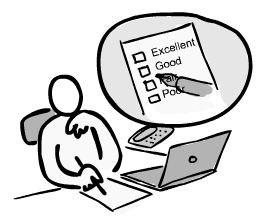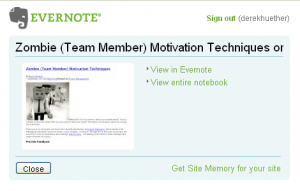What skills do you need to lead your zombie army? Sorry, what I meant to ask was, what skills do you need to lead your team? Motivation techniques can be as unique as the individual. There are a lot of people out there who identify themselves as project managers, those tasked with managing inanimate resources (time, scope, budget...zombies). Though those skills are necessary, there is a need for skills to lead teams and manage stakeholders. I'm talking (soft) skills to lead, manage, and inspire human resources.
Provide Feedback
You can't expect your team to operate in a vacuum. As a team member, imagine if your manager provided an annual review and then didn't provide feedback to you until the next annual review. That would be a clear failure on the part of the manager or leader. I believe managers and leaders are obligated to provide continual feedback to the team. Now, if managing a zombie team member, no feedback is needed. They'll keep searching for brains until someone either shoots them in the head or decapitates them. Either way, providing feedback will probably only result in you being chased by a horde of flesh eating zombies.
Recognize Performance
Let's look at this from both a positive and a negative perspective. If your team is not doing a good job, you need to recognize their performance (both as a group and individually) and give constructive feedback so they can meet your expectations. If they are meeting your expectations, you need to reinforce what you like so they can continue to meet those expectations or exceed them. Recognizing zombie team performance is like watching someone win a pie eating contest. They eat (brains). Put another brain in front of them and they'll eat it. Repeat ad nauseum. How well they perform is limited by nothing but time.
Negotiate
Don't be an unreasonable person. Recognize that some team members will not feel comfortable with some goals set for them. Win-win negotiations should help you arrive at the desired outcome. With constant feedback and motivation, believe any team member can reach any goal you set for them. Note, don't set the bar too low and give them a false win. Do not believe in "stretch" goals. Negotiate realistic outcomes. Most importantly, don't negotiate with zombies! Zombies are like terrorist, except they have a green skin tone and look at you like an opened can of Spam sitting in the hot sun for a week.
Motivate and Persuade
Have you heard the idiom you can catch more bees with honey than you can with vinegar? Get to know each of your team members personally and find out what motivates them. What's important to them; coffee, family time, or recognition? You may buy one team member a coffee gift card, tell another to go home early, or thank another publicly in a meeting. Everyone has something that motivates them. If you ever order lunch for the team, make sure you consider everyone (individually). When you set schedules, try to consider individual family obligations.
Respect
Respect is fundamental in any relationship. You will get the very best from people if you have mutual respect. I once had a superior ask me if I wanted my team to respect me or to like me. My response was OR? Why can't they do both? Teams will respect you if they know you would never throw them under the bus to protect yourself. Take the hits from management if you don't reach a goal. Protect the team at all costs. As a result, the team should do everything they can to prevent that situation from happening. Zombies are not team players. They want your brains and they will throw you under a bus at the first opportunity. Don't judge them. They know not what they do.
Summary
If you're going to be a project manager who is managing people, you need to have good soft skills. That is, you need the ability to engage and interact effectively with your team, obtain acceptance, build consensus, and provide assistance, direction and leadership.
I'm a strong believer that if you treat people with honesty and respect and your motives are good, it will come back to you. That means be genuinely concerned about the well-being and happiness of your team. Listen to them and guide them. Whatever the business side expects of you will get taken care of. Your team will rise to the challenge. I've known project managers who lacked some of these skills. Either they didn't provide feedback to their team or they were unreasonable or demanding. The team was miserable, productivity went down, and that manager blamed the team. It was a vicious cycle.
Sometimes, you just have to do what you know is right and face the consequences.
Sometimes, you have to fight the urge to eat brains.
Photo: flickr user frogmuseum2
 And so concludes my second day at the PMI North American Congress. Again, it was an awesome day.
I went to 4 different Agile centric sessions. Titles included
And so concludes my second day at the PMI North American Congress. Again, it was an awesome day.
I went to 4 different Agile centric sessions. Titles included







